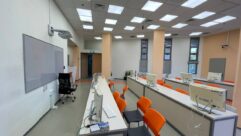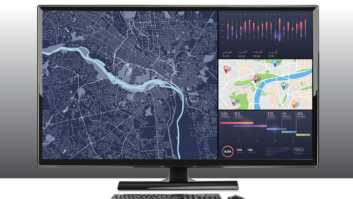
Custom AV Technology Enhances R&D
AstraZeneca R&D Boston relies on high-resolution projection to display complex 3D images for scientific applications.
As a major international pharmaceutical company, United Kingdom-based AstraZeneca relies on AV and a collaborative environment in its research and development efforts of gastrointestinal, cancer, cardiovascular, neuroscience, and infection products. The company has maintained a research presence in the Boston area since 1995. With the most recent expansion in October of 2003, AstraZeneca’s Waltham, MA, facility now contains 250,000 square feet of laboratory and office space.
The need for 3DOptical technology
CHALLENGE: Fill the need for reliable, accurate, high-quality 3D projection of computer generated graphics at a reasonable cost.
SOLUTION: Install a custom designed stereoscopic 3D image projection system based on LCoS technology.
THE TOTAL number of prescriptions written in America is now at 3 billion per year, with the average annual number of prescriptions per person at 12. Despite the staggering statistics, most people don’t think very much about how their prescription medication came into existence, or how AV plays a role in the development process.
The AstraZeneca R&D Boston facility features 25 in-house collaboration rooms. This 15- by 20-foot room is reserved for its 3D projection system, which includes a Canon Realis sX50 projector.
As one of nine AstraZeneca research and development facilities around the world, the Boston-area facility works within the larger context of the global company. “Our goal is to provide content for scientific applications,” says Tony DeFrancisco, AV manager at AstraZeneca R&D Boston. Stereoscopic 3D collaborations between the scientists happen about once per week.
The research conducted at the facility focuses on developing innovative new therapies within the cancer and infectious disease areas. As one of nine R&D centers, AstraZeneca R&D Boston specializes in discovery-phase research, the step that precedes human clinical trials.
While most consumers associate 3D image projection with an IMAX movie, the pharmaceutical industry often uses this technology to view high-resolution computer renderings of complex molecule structures and chemical compounds. In fact, stereoscopic 3D image projection can provide a powerful and effective means of communicating visual information — especially in a scientific environment. However, high-resolution systems capable of 3D projection can be large and expensive. DeFrancisco needed an alternative to the costly stereoscopic 3D image presentation systems currently on the market, and preferred a system that was compact, easy to operate, and affordable.
The AstraZeneca R&D Boston facility has 25 in-house collaboration rooms complete with a Tandberg 2500 videoconferencing system and a NEC Multisync MT1060 ceiling projector with a drop-down projection screen. AstraZeneca believes in collaboration and communication both within and between each facility, and has invested in 320 Tandberg systems corporate-wide.
One of the 25 rooms is reserved for the 3D projection system. The 15- by 20-foot room can hold about 20 people. “We had another portable projection system installed there, but we wanted something more static,” DeFrancisco explains. “The old system had outdated projectors, and we needed better viewing resolutions and a longer throw capability. Most of the 3D systems out there are packaged units; we went to one 3D vendor that wanted $60,000 for their system.”
XPO STEREO 3D CONVERTER
The Inition PO stereo 3D converter AstraZeneca Boston uses in its 3D projection room provides higher quality visualization by using the latest LCD and DLP projectors to display passive stereoscopic 3D. Because LCD and DLP projectors are designed specifically for digital data and video, they render the digital computer image sharper and more accurate than existing active CRT solutions.
The XPO converter is flexible because it works independently of both the source and projectors. Consequently, it’s compatible with the standard stereo signal output of any computer and can be applied with any projector type, regardless of brand.
The XPO converter can also be combined with existing active CRT solutions because it uses the same signal. Additional applications include head-mounted displays, side-by-side projector installations (“powerwalls”), front and rear projection with screen sizes of up to 500 inches, and portable 3D solutions.
The XPO system converts an incoming stereo 3D signal to two monitor signals — one monitor signal for the right eye and one for the left eye. The signals are then routed to two projectors, which are stacked and project images in register.
To attain a 3D effect, a polarized filter must be fitted in front of the lens on each projector, and the images must be viewed through polarized 3D glasses.
— Inition.com
During his research for a more affordable solution, DeFrancisco came across a projector with SXGA+ (1400×1050) resolution that seemed to fit his technical requirements, as well as his budget. “I went out and did some research and found the Canon Realis SX50,” he says. The projectors list for $4,999 each.
According to Canon, the Realis SX50 is currently the world’s smallest and lightest LCoS projector. It offers 2,500 ANSI lumens, a 1,000:1 contrast ratio, a Canon zoom lens, and incorporates the company’s patented AISYS (Aspectual Illumination System) optical technology.
“I bought a pair of Realis SX50s and mounted them in the existing VRex rack,” he says. “When I upgraded the projectors, I also recalibrated the projection so it overlaps at just the right distance for a 3D image. There’s also a little interface box that works with the computer to output the 3D image that gets the signal to the projectors in the right format. Our scientists create 3D graphics of chemical compounds and molecules using computer software; then they bring those files to the AV room, put the 3D glasses on, and view the stereo images.”
A 3D video card in the computer is required to render the image, and 3D software creates the content. To output the image, the computer’s signal is matrixed using an Inition XPO2 stereo 3D converter that enables high-end stereoscopic 3D visualization using standard LCD and DLP projectors and a regular PC workstation.
In an optimum 3D projection environment, it’s best not to have any light in the room. The total darkness makes for a crisp, realistic 3D stereoscopic image.
In the AstraZeneca facility, images from the Realis projection system are projected onto a special Stewart Filmscreen silver screen designed for passive 3D use. The screen’s silvery, aluminized screen finish enhances 3D images, but due to the nature of the material, this type of screen can only be used in a fixed installation.
FOR MORE INFORMATION
Canon www.canon.com
ClearOne www.clearone.com
Crown www.crownaudio.com
Inition www.inition.com
JBL www.jblpro.com
Stewart www.stewartfilmscreen.com
Tandberg www.tandberg.net
VRex www.vrex.com
“The images really show up well with our setup,” DeFrancisco says. “If the Realis SX50 was lacking in any way, our AV room would show it, but the projector does exactly what I was looking for. And I think the biggest selling point of the projector is its size. It’s a very compact unit. If you have to travel to make a presentation, you can just put it in a case, take it with you, and really wow people with these high-resolution images. The custom stereoscopic 3D image display setup has definitely impressed the scientists, which is my goal. The projectors produce a sharp, clear picture.”
Canon’s proprietary AISYS optical technology enables the Realis SX50 to achieve the high brightness of 2,500 ANSI lumens and a contrast ratio of 1,000:1, while also reducing projector size. According to Canon, AISYS maximizes the performance of LCoS technology, which the company believes offers advantages over traditional projection methods.
Canon claims that the Realis SX50 projector also allows colors to be matched and adjusted with great precision, which is an important added benefit for applications in scientific environments.
“With the scientists using their specific applications and programs, they’re getting a lot of use out of our custom stereoscopic 3D image display setup,” DeFrancisco adds.
Because the 3D collaborations don’t require interactive audio, a microphone isn’t necessary in the room. However, there’s a small reinforcement system that’s available for use in meetings or presentations. The existing sound reinforcement system includes a ClearOne XAP 800 teleconferencing system, Crown Audio amplifiers, and wall-mounted JBL 25WH loudspeakers. DeFrancisco says AstraZeneca could use the system for a 3D movie in the future, although that capability hasn’t been explored yet.
As part of a continuing investment in AV technology, AstraZeneca R&D Boston also recently completed an additional $750,000 installation, including upgrades for a new 150-seat auditorium with twin NEC GT1150 projectors and custom-made, $15,000 25-foot-wide projection screens.
Linda Seid Frembes is a freelance writer and PR specialist for the professional AV industry. She can be reached at [email protected].










